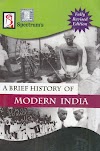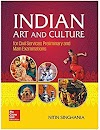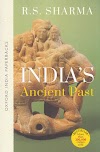Different Stages of Colonialism in Princely States and the Rise of Leftists/Left wing
"Colonialism deprives you of your self-esteem and to get it back you have to fight to redress the balance"
Different Stages of Colonialism in the Princely States
The different stages of colonialism in the princely states are as follows -
- Stage 1 - 1740 to 1765 (East India Company's struggle for equality with the Princely States)
- Stage 2 - 1765 to 1813 (Policy of Ring Fence)
- Stage 3 - 1813 to 1857 (Policy of Sub-ordinate isolation)
- Stage 4 - 1857 to 1935 (Phase of Sub-ordinate union)
- Stage 5 - 1935 till independence (Phase of equal federation)
Stage 1 (East India Company's struggle for equality with Princely States) -
- Year - 1740 to 1765
- The first European to interfere in the internal matters of the Princely State was French Governor Dupleix, but this strategy was mastered by the British East India Company (EIC).
- Slowly, they changed their sub-ordinate status to the equal of Indian Princely States after the Battle of Plassey, Battle of Buxar and Battle of Wandiwash.
Stage 2 (Policy of Ring Fence)
- Year - 1765 to 1813
- The policy of Ring Fence doctrine was enacted by Warren Hasting. It involved defending their neighbour's frontier in order to safeguard his own territory.
- British authority created a buffer zone around their political territory to protect themselves from any foreign attack as well as large Indian powers.
- To pursue this objective, Subsidiary Alliance was used.
Stage 3 (Policy of Sub-Ordinate Isolation)
- Year - 1813 to 1857
- The policy of sub-ordinate isolation needs the states to relinquish all form of external sovereignty while retaining internal administration sovereignty.
- With the arrival of Hastings, the Government of India tried to establish British paramountcy in India.
- They signed separate agreements with the princely states not on the basis of equality but by claiming that British authority is paramount and supreme.
- The most frequent and draconian policy tool at this time was Lord Dalhousie's Doctrine of Lapse.
Stage 4 (Phase of Sub-Ordinate Union)
- Year - 1857 to 1935
- After the Revolt of 1857, British crown maintained that there would be end of policy of annexation and British crown will directly assume the power in India.
- Moreover, Queen Victoria took the title of 'Kaiser-i-HInd' (Empress of India) in 1876.
- In 1921, Chamber of Princes was created to provide a common platform for discussing the problems of Princely States.
- In 1927, Butler Commission was appointed to streamline the relation between princely states and the British government.
Stage 5 (Phase of equal federation)
- Year - From 1935 till independence
- Britishers were trying to establish an all India federation through Government of India Act of 1935.
- However, the rulers of princely states rejected it and the federation never came into existence.
National Freedom Movement in Princely States
Right from the 1920s, mass movement started to influence the people of princely states too. In this regard they created first political organisation 'States People Conference' in 1927 with the efforts of Balwant Rai, M.L. Kothari and G.R. Abhyankar.
In 1929, Lahore Session of the Indian National Congress, Jawahar Lal Nehru proposed to merge the freedom movement in princely states with the national freedom movement. But it was rejected.
In 1939, All India States People Conference appointed Jawahar Lal Nehru as its president in Ludhiana Session so as to merge it with the national freedom movement.
Finally, the movement in princely states was merged with the national freedom movement during the Quit India Movement.
Rise of the Left and Communist Party of India
Socialism started to take shape in India in the third decade of the 20th century. The greatest initial representative of social though in India was Jawahar Lal Nehru.
Later in 1934, Congress Socialist Party was creates by Acharya Narendra Dev, Jay Prakash Narayan, Ram Manohar Lohiya and Minoo Masani.
Communist Party of India (CPI) was created by M.N. Roy in 1920 at Tashkent. The formal announcement of this party in India was made by Satyabhakt at Kanpur in 1924.
Other Communist Parties -
- Labour Swaraj Party of INC - It was created by people like Muzaffar Ahmad, Nazrul Islam and Hemant Kumar Sarkar.
- In 1928, Workers and Peasants Party was created by merging the following party.
- Congress Swaraj Party of Bombay
- Kirti Kisan Party of Punjab
- Labour Swaraj Party of Madras
From the very beginning, Britishers were against the spread of communism in India. They started several conspiracy cases to arrest communist leaders which includes -
- Peshawar conspiracy case (1922)
- Kanpur Bolshevik case (1924) - Four important leaders were arrested who were Muzaffar Ahmad, Nalimi Gupta, Shaukat Usmani and S.A. Dang.
- Meerut conspiracy case (1929) - 32 prominent communist leaders were arrested which included 3 British officers, Ben Bradley, Philips Spratt and Lester Hutchinson.
In 1934, when Britishers declared Communist Party of India (CPI) as illegal, it was re-organised by P.C. Joshi.
At the beginning of the World War II, CPI declared it to be imperialist war but when Germany invaded Russia, CPI changed its stance and declared World War II as People's War. They started to support British and in turn it was declared as a legal party again.
CPI did not participated in Quit India Movement but many communist leaders participated in the movement on their personal capacity but as a party CPI did not participated.
Previous Article - Development of Press during British period
Next Article - Peasant Movements and Organisations
Notes on other subjects
Optional Subject
Note - This is my Vision IAS Notes (Vision IAS Class Notes) and Ashutosh Pandey Sir's Public Administration Class notes. I've also added some of the information on my own.
Hope! It will help you to achieve your dream of getting selected in Civil Services Examination 👍





0 Comments